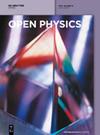采用卡塔尼奥-克里斯托夫热通量和质量通量模型的第二级磁流体流过拉伸表面的对流
IF 1.8
4区 物理与天体物理
Q2 PHYSICS, MULTIDISCIPLINARY
引用次数: 0
摘要
本研究深入探讨了受拉伸片上陀螺状微生物存在影响的磁流体二级流体流动动力学。研究考虑了各种因素,如热辐射、化学反应性和活化能,所有这些因素都导致了该系统中流体流动的复杂行为。磁场与流体之间的相互作用,再加上陀螺触动微生物引入的生物因素,增加了整体分析的复杂性。数学模型以偏微分方程(PDE)的形式呈现。利用相似变量,将建模的偏微分方程转换为常微分方程。模型方程的求解采用了同调分析方法。在对这一研究进行详细了解后,确定速度分布随着磁性因子和二级流体参数的增长而下降。辐射因子、热泳因子和布朗运动因子的数值越大,热特性就越强,而热弛豫时间因子和普朗特数的数值越大,这些特性就越弱。浓度特征随着施密特数、质量弛豫时间、化学反应和布朗运动因子的增加而减弱,但随着活化能和热泳因子的增加而增强。微生物曲线是生物对流路易斯数和佩克雷数的递减函数。这项研究包括一项比较分析,它与现有研究密切吻合,显示出与已有研究结果的高度一致性。本文章由计算机程序翻译,如有差异,请以英文原文为准。
Convective flow of a magnetohydrodynamic second-grade fluid past a stretching surface with Cattaneo–Christov heat and mass flux model
This research delves into dynamics of magnetohydrodynamic second-grade fluid flow influenced by the presence of gyrotactic microorganisms on a stretching sheet. The study takes into account various factors such as thermal radiation, chemical reactivity, and activation energy, all of which contribute to the complex behavior of fluid flow in this system. The interaction between the magnetic field and the fluid, combined with the biological aspect introduced by gyrotactic microorganisms, adds complexity to the overall analysis. The mathematical model is presented in the form of partial differential equations (PDE)s. Using the similarity variables, the modeled PDEs are transformed into ordinary differential equations. Homotopy analysis method is used for the solution of the modeled equations. After a detailed insight into this investigation, it is established that the velocity distribution declined for growth in magnetic factor and second-grade fluid parameter. The thermal characteristics are augmented for the greater values of radiation, thermophoretic and Brownian motion factors, while these profiles are weakened for upsurge in thermal relaxation time factor and Prandtl number. The concentration characteristics declined with the enhancement in Schmidt number, mass relaxation time, chemical reaction, and Brownian motion factors, while they amplified with enhancement in activation energy and thermophoresis factors. The microorganisms’ profiles are the declining functions of bioconvection Lewis and Peclet numbers. This study included a comparative analysis, which aligns closely with existing research, demonstrating a strong concordance with established findings.
求助全文
通过发布文献求助,成功后即可免费获取论文全文。
去求助
来源期刊

Open Physics
PHYSICS, MULTIDISCIPLINARY-
CiteScore
3.20
自引率
5.30%
发文量
82
审稿时长
18 weeks
期刊介绍:
Open Physics is a peer-reviewed, open access, electronic journal devoted to the publication of fundamental research results in all fields of physics. The journal provides the readers with free, instant, and permanent access to all content worldwide; and the authors with extensive promotion of published articles, long-time preservation, language-correction services, no space constraints and immediate publication. Our standard policy requires each paper to be reviewed by at least two Referees and the peer-review process is single-blind.
 求助内容:
求助内容: 应助结果提醒方式:
应助结果提醒方式:


